Exposure and impact of sports and race betting advertising in Australia
March 2023
Rebecca Jenkinson, Cailem Murray Boyle, Kei Sakata, Nancy Greer, Uma Jatkar, Brian Vandenberg
Download Research snapshot
Key messages
-
Around three-quarters (78%) of Australian adults reported seeing or hearing sports and/or race betting (wagering) advertising at least once a week in the past 12 months; two in five (41%) were exposed four or more times a week.
-
Young people aged 18-34 years were more likely to be exposed to wagering advertising in 'interactive media' (e.g. social media, online), and people aged 55+ years in 'traditional media' (e.g. TV, radio, print media).
-
People who were exposed to wagering advertising at least weekly were more likely to:
- have spent money gambling on sports and racing
- be classified as being at risk of gambling harm.
-
Seeing or hearing wagering advertising influenced betting behaviour among people who gambled: 21% were prompted to start betting for the first time, 28% changed what they bet on or tried a new form of betting, 29% placed bets on impulse and 34% increased the amount they bet.
-
Young people (aged 18-34 years) and people at risk of gambling harm were much more likely to report that seeing or hearing gambling advertising in the past 12 months had impacted their betting behaviour:
- One in five young women (19%) and one in seven young men (15%) started betting for the first time after seeing or hearing an ad on TV.
- Young people most often increased their betting in response to ads on TV and through interactive media (e.g. direct messages, social media, streamed content).
- Among those at risk of gambling harm, half (50%) reported increasing their betting after seeing or hearing wagering ads (across all platforms) and two in five changed what they bet on or tried a new form of betting (41%) or bet on impulse (40%).
How are Australians exposed to wagering advertising?
Wagering operators use a diverse and increasingly sophisticated range of advertising platforms and strategies to promote their services, including in traditional media and via online/interactive modes. We asked survey participants where and how often they had seen or heard advertising for sports and/or race betting in the past 12 months. Two in five (41%) Australian adults were exposed to wagering advertising four or more times a week in the past 12 months, while around three-quarters (78%) were exposed at least once a week. Television ads were the ads seen or heard most frequently by Australians; around a third (32%) reported being exposed to these four or more times a week. This was followed by wagering advertising on online platforms (e.g. news websites) (11%), sporting team/player uniforms or merchandise (10%) and social media (10%).
Figure 1: Where and how often Australian adults had seen or heard wagering advertising
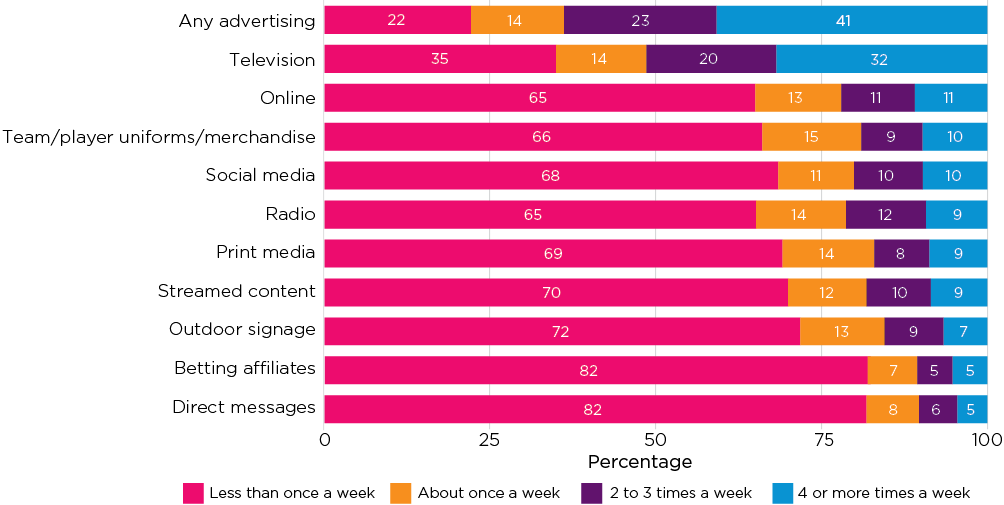
Notes: Australian adults (whole sample; n = 1,765). Australian Bureau of Statistics (ABS) weights (age/gender) used for estimation. Examples of media platforms: online (e.g. news websites, YouTube), social media (e.g. Facebook), streamed content (e.g. Kayo, SBS on demand), outdoor signage (e.g. stadiums, billboards), betting affiliates (e.g. through third-party publishers, bloggers/tipsters), direct messages (e.g. email, text message). Percentages may not total 100.0% due to rounding.
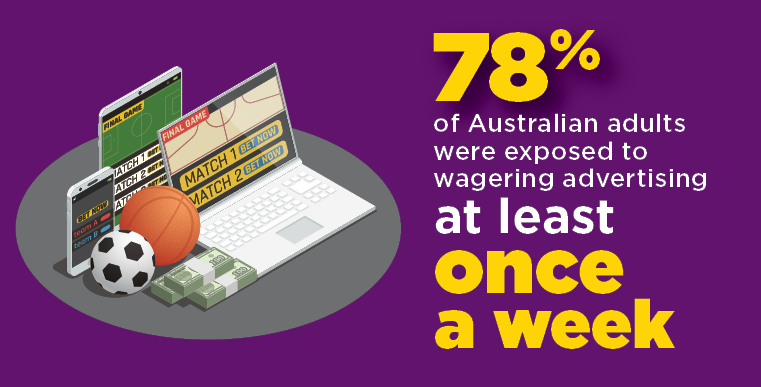
Who is exposed to wagering advertising?
Men were more likely than women to report being exposed to wagering advertising (at least once a week) (Figure 2). Young people aged 18-34 years were more likely than older age groups to report exposure to wagering advertising in 'interactive media' platforms (i.e. streamed content, social media, online, direct messages, betting affiliates) (Figure 3). Those aged 55 or older were more likely to report exposure to wagering advertising in 'traditional media' (i.e. TV, radio, print media, team/player uniforms or merchandise and outdoor signage).
Figure 2: Proportion (a) by gender and (b) by age who were exposed to wagering advertising at least weekly in 'traditional media' and 'interactive media'
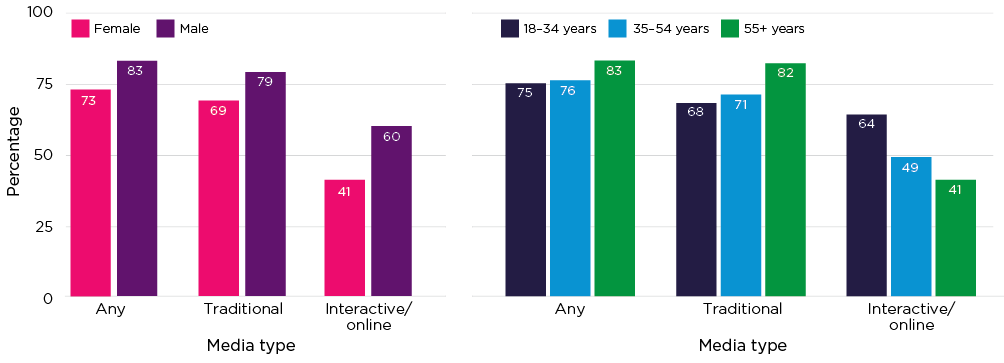
Notes: Female (n = 887), Male (n = 865); 18-34 years (n = 549), 35-54 years (n = 595), 55+ years (n = 621). Participants whose response to gender identity was 'non-binary' or 'prefer not to say' were not included in the gender analysis due to small sample size. ABS weights used for estimation.
What is the relationship between exposure to advertising and participation in betting?
There was a strong association between seeing and/or hearing wagering advertising in the past 12 months and betting on sports and racing during that time (Figure 3). Australians who were exposed to wagering advertising weekly or more often on any media platform, but especially via interactive/online media platforms (e.g. social media, streamed content), were much more likely to have spent money gambling on sports and racing (horse, greyhound and harness), compared to those who were exposed to advertising less than weekly.
Figure 3: Exposure to wagering advertising and participation in sports and race betting
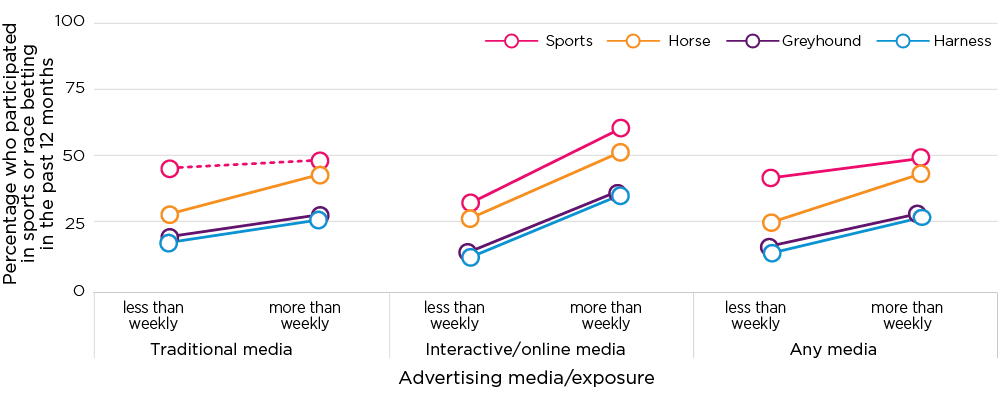
Notes: Australian adults (whole sample; n = 1,765). ABS weights used for estimation. Dotted line (sports, traditional media) not significant at p > 0.05; complete lines significant at p < 0.05.
What is the association between exposure and at-risk gambling?
At-risk gambling was assessed among those who had bet on sports and/or racing in the past 12 months using the Problem Gambling Severity Index (PGSI).1 We found that sports and race bettors who were exposed to wagering advertising more often in the past 12 months (i.e. weekly or more) were more likely to be classified as being at risk of gambling harm (Figure 4). The relationship between frequency of exposure and risk of harm was significant across all advertising platforms except for print media (and the association for TV was reversed). Higher levels of at-risk gambling were found among sports and race bettors who were regularly exposed to wagering advertising via online/interactive modes (e.g. betting affiliates, direct messages, social media, online).
Figure 4: Exposure to wagering advertising and proportion classified as being at risk of gambling harm (among those who bet on sports or racing)
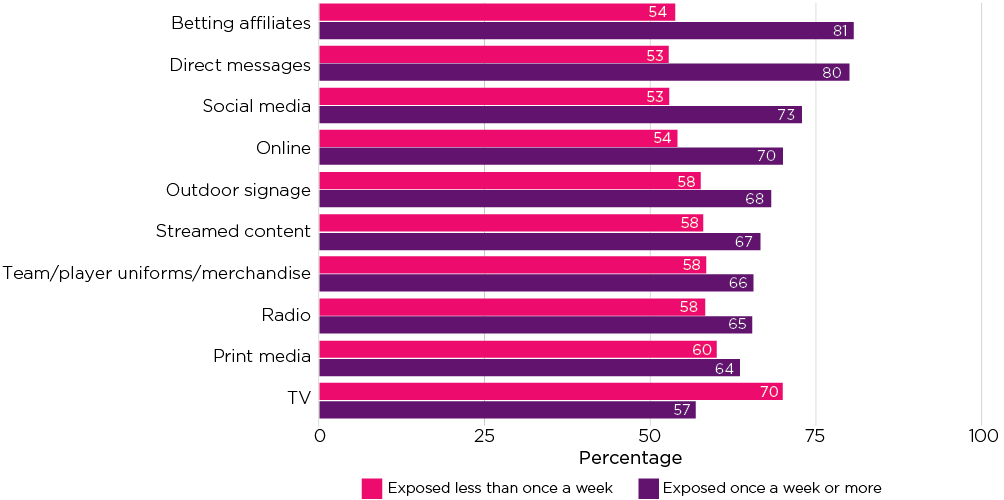
Notes: Australian adults who bet on sports and/or racing in past 12 month (n = 782). ABS weights used for estimation. All differences significant at p < 0.05 except for print media.
How does exposure impact betting behaviour?
Seeing or hearing sports or race betting advertising in the past 12 months impacted betting behaviour in a number of ways. A fifth of those who gambled (21%) reported being prompted to bet for the first time after seeing or hearing a wagering advertisement, over a quarter changed what they bet on or tried a new form of betting (28%) or placed bets on impulse (29%), and a third (34%) reported being prompted to increase the amount they bet on sports or racing after seeing or hearing wagering adverisements.
Those who bet on sports or racing reported that all advertising platforms influenced their gambling behaviour in some way (Figure 5). Placing a bet for the first time was often influenced by seeing or hearing wagering ads on TV, changing what they bet on or trying a new form was often influenced by streamed content or social media, and placing bets on impulse and increased betting were often influenced by direct messages.
Figure 5: Impact of types of wagering advertising on betting behaviours among those who gambled on sports or racing in the past 12 months
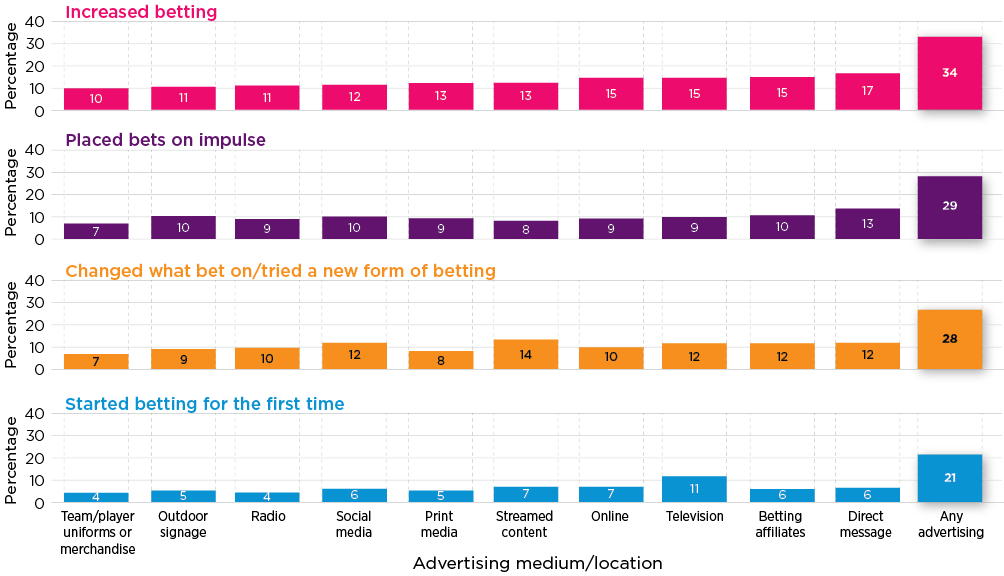
Notes: Self-reported exposure to any wagering advertising and bet on sports and/or racing in past 12 months (n = 770). Sample size varied by advertising platform - min: direct messages (n = 496), max: television (n = 748). ABS weights used for estimation.
Who is most influenced by exposure to betting advertising?
Among those who had bet on sports or racing in the past 12 months, young people (aged 18-34 years) and people at risk of gambling harm were much more likely to report that exposure to wagering advertising had impacted their betting behaviour (Table 1).
| Prompted to start betting for the first time (%) | Prompted to change what I bet on, or to try a new form of betting (%) | Prompted to place bets on impulse (%) | Prompted to increase my betting (%) | ||
|---|---|---|---|---|---|
| Male | 18-34 (n = 194) | 32 | 42 | 41 | 48 |
| 35-54 (n = 169) | 22 | 30 | 32 | 39 | |
| 55+ (n = 120) | 6 | 9 | 16 | 16 | |
| Female | 18-34 (n = 109) | 28 | 41 | 39 | 49 |
| 35-54 (n = 104) | 19 | 21 | 22 | 33 | |
| 55+ (n = 73) | 4 | 4 | 7 | 4 | |
| At-risk gambling | Not at-risk (n = 292) | 6 | 6 | 10 | 10 |
| At-risk (n = 478) | 30 | 41 | 40 | 50 | |
| Total | (n = 770) | 21 | 28 | 29 | 34 |
Notes: Sample includes participants who reported exposure to any wagering advertising and had bet on sports and/or racing in past 12 months (n = 770). Participants whose response to gender identity was 'non-binary' or 'prefer not to say' were not included in the gender analysis due to small sample size. ABS weights were used for estimation.
While young men and women reported being influenced to a similar extent by any wagering advertising, there were differences across advertising platforms. For example, we found that:
- Among young men (aged 18-34 years):
- one in seven (15%) started betting for the first time after seeing or hearing wagering ads on TV
- one in five increased their betting in response to ads on TV (20%) and social media (20%).

- Among young women (aged 18-34 years):
- one in five (19%) started betting for the first time after seeing or hearing wagering ads on TV
- one in five increased their betting in response to ads on TV (19%), streamed content (22%), online (22%) and in direct messages (23%).
- Among people at risk of, or already experiencing, gambling problems:
- half (50%) were prompted to increase their betting after seeing or hearing any wagering ads (Table 1); typically this was in response to ads on TV (22%), online (20%), via direct messages (20%) and betting affiliates (19%)
- two in five were also prompted to bet on impulse (40%) or change what they bet on/try a new form of betting (41%) in response to any wagering advertising in the past 12 months.
Our survey
An online general community panel survey was conducted in July 2022. A sample of 1,765 Australian residents aged 18 years and over, aligned with ABS population parameters of age, gender and location of residence (metro and non-metro), completed the survey. We explored participants' views on sports and race betting advertising by asking how much they agreed with a range of statements on a scale from 'strongly disagree' to 'strongly agree', and whether they 'supported' or 'opposed' a range of potential policy responses. As part of the survey, we also asked participants about their gambling participation in the past 12 months, including what products they gambled on, how much they spent, what platforms/modes they used to gamble, and how gambling impacted their health and wellbeing. We partnered with ORIMA Research and the Online Research Unit (ORU) to collect the survey data.
See all survey snapshots
- Gambling participation, experience of harm and community views
- Gambling participation and experience of harm in Australia
- Community attitudes towards sports and race betting advertising in Australia
News stories
- Cut-off time: Support for banning gambling ads before 10.30pm| The Age
- Two thirds of Australians believe gambling ads are 'too common'| ABC News
- New Report Reveals Harmful Impact Of Gambling Ads| 10 News First Twitter
- Fresh Measures To Reduce Gambling Harm In Aussie Families| 10 News First Twitter
- Majority of Australians support banning gambling advertising on TV, study finds| The Guardian
- Young Australians being exposed to tsunami of powerful gambling ads, study reveals| 9News
- Support for ban on gambling ads| ABC News
- Most Australians support banning gambling ads: research| ABC News
- 'Destroying lives': Calls for action as survey finds two in five Australian adults gamble weekly| SBS News
- 'Money off misery': Crossbenchers demand Labor crack down on gambling ads, political donations| SBS News
- New research finds three-quarters of Australian adults have gambled at least once over the past 12 months| The West Australian
1 Respondents were grouped into four categories based on their scores: non-problem gambling (0), low-risk gambling (1-2), moderate-risk gambling (3-7) and problem gambling (8-27). Respondents scoring 1+ may be classified as being at some risk of, or already experiencing, gambling problems.
Contributions and acknowledgements
This research was conducted by the Australian Gambling Research Centre (AGRC) team at the Australian Institute of Family Studies: Dr Rebecca Jenkinson, Cailem Murray Boyle, Dr Kei Sakata, Nancy Greer, Uma Jatkar and Dr Brian Vandenberg.
Featured image: © GettyImages/glegorly
Suggested citation
Australian Gambling Research Centre. (2023). Exposure and impact of sports and race betting advertising in Australia. Melbourne: Australian Gambling Research Centre, Australian Institute of Family Studies.
Download Research snapshot
Related publications

Gambling participation, experience of harm and community…
AGRC recently asked Australian adults about their participation in gambling, attitudes towards wagering advertising,…
Read more
Gambling participation and experience of harm in Australia
This snapshot explores how often Australians gamble, how much they spent, their risk of gambling harm, what products…
Read more
Community attitudes towards sports and race betting…
Overall, this snapshot finds that 69% of Australian adults think that sports and race betting advertising is too common…
Read more